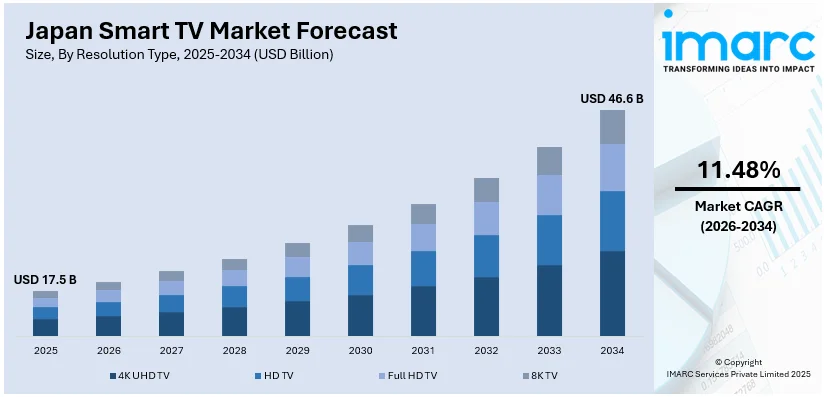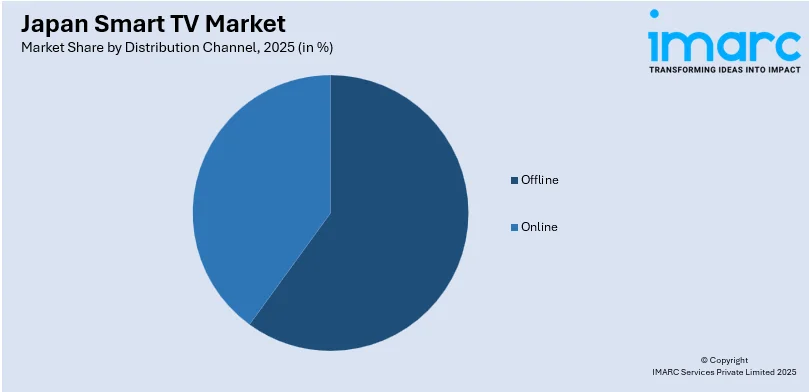
Japan Smart TV Market Report by Resolution Type (4K UHD TV, HD TV, Full HD TV, 8K TV), Screen Size (Below 32 Inches, 32 to 45 Inches, 46 to 55 Inches, 56 to 65 Inches, Above 65 Inches), Screen Type (Flat, Curved), Technology (Liquid Crystal Display (LCD), Light Emitting Diode (LED), Organic Light Emitting Diode (OLED), Quantum Dot Light Emitting Diode (QLED)), Platform (Android, Roku, WebOS, Tizen OS, iOS, MyHomeScreen, and Others), Distribution Channel (Offline, Online), Application (Residential, Commercial), and Region 2026-2034
Market Overview:
Japan smart TV market size reached USD 17.5 Billion in 2025. Looking forward, IMARC Group expects the market to reach USD 46.6 Billion by 2034, exhibiting a growth rate (CAGR) of 11.48% during 2026-2034. The growing demand for enhanced connectivity and entertainment options, increasing evolution of display technologies, such as 4K and 8K resolutions, and rising prevalence of over-the-top (OTT) content streaming platforms and services represent some of the key factors driving the market.
|
Report Attribute
|
Key Statistics
|
|---|---|
|
Base Year
|
2025 |
|
Forecast Years
|
2026-2034
|
|
Historical Years
|
2020-2025
|
| Market Size in 2025 | USD 17.5 Billion |
| Market Forecast in 2034 | USD 46.6 Billion |
| Market Growth Rate (2026-2034) | 11.48% |
Smart television (TV) is designed to offer an enhanced viewing experience by providing access to various online content and services, transforming the way we interact with and consume media. It is equipped with built-in wireless fidelity (Wi-Fi) or Ethernet ports, allowing it to connect to the internet seamlessly. It runs on dedicated operating systems (OS), providing a user-friendly interface for accessing apps and content. It supports a variety of apps, much like smartphones, which extend their functionality by providing access to content, games, and utilities. It also comes with advanced remote controls, often including voice recognition, motion control, and touchpad capabilities. It uses various screen technologies, including organic light emitting diode (OLED), quantum dot light emitting diode (QLED), and LED to offer superior picture quality and immersive viewing experiences. It provides access to a vast library of streaming services, allowing users to watch what they want when they want. It also enables users to personalize their experience by downloading apps and customizing the interface to suit their preferences. It often integrates with smart home devices, allowing users to control lights, thermostats, and other devices from their TV screens. It can eliminate the need for additional devices like cable boxes or streaming sticks, potentially saving users money in the long run.

To get more information on this market, Request Sample
Japan Smart TV Market Trends:
At present, the escalating demand for enhanced connectivity and entertainment options represents one of the crucial factors impelling the growth of the market in Japan. Besides this, the rising evolution of display technologies, such as 4K and 8K resolutions, coupled with improved processing power, is enabling smart TVs to deliver improved visual quality and performance. In addition, the growing prevalence of over-the-top (OTT) content streaming platforms and services, which can be seamlessly accessed through smart TVs, is offering a favorable market outlook in the country. Individuals are increasingly seeking energy-efficient and eco-friendly appliances, and smart TVs are aligning with this trend by incorporating energy-saving features and adhering to stringent energy efficiency standards. Apart from this, the concept of a connected and automated home is gaining traction with smart TVs serving as a central hub for controlling various smart devices. Moreover, ongoing innovations in artificial intelligence (AI) and machine learning (ML) are providing features like content recommendations, voice search, and personalized viewing experiences and enhancing the overall user experience, making smart TVs more attractive to individuals. Furthermore, the growing installation of smart TVs in restaurants, clubs, and cafes to stream various content is positively influencing the market in the country.
Japan Smart TV Market Segmentation:
IMARC Group provides an analysis of the key trends in each segment of the market, along with forecasts at the country level for 2026-2034. Our report has categorized the market based on resolution type, screen size, screen type, technology, platform, distribution channel, and application.
Resolution Type Insights:
- 4K UHD TV
- HD TV
- Full HD TV
- 8K TV
The report has provided a detailed breakup and analysis of the market based on the resolution type. This includes 4K UHD TV, HD TV, full HD TV, and 8K TV.
Screen Size Insights:
- Below 32 Inches
- 32 to 45 Inches
- 46 to 55 Inches
- 56 to 65 Inches
- Above 65 Inches
A detailed breakup and analysis of the market based on the screen size have also been provided in the report. This includes below 32 inches, 32 to 45 inches, 46 to 55 inches, 56 to 65 inches, and above 65 inches.
Screen Type Insights:
- Flat
- Curved
The report has provided a detailed breakup and analysis of the market based on the screen type. This includes flat and curved.
Technology Insights:
- Liquid Crystal Display (LCD)
- Light Emitting Diode (LED)
- Organic Light Emitting Diode (OLED)
- Quantum Dot Light Emitting Diode (QLED)
A detailed breakup and analysis of the market based on the technology have also been provided in the report. This includes liquid crystal display (LCD), light emitting diode (LED), organic light emitting diode (OLED), and quantum dot light emitting diode (QLED).
Platform Insights:
- Android
- Roku
- WebOS
- Tizen OS
- iOS
- MyHomeScreen
- Others
The report has provided a detailed breakup and analysis of the market based on the platform. This includes android, roku, webOS, tizen OS, iOS, myhomescreen, and others.
Distribution Channel Insights:

Access the Comprehensive Market Breakdown, Request Sample
- Offline
- Online
A detailed breakup and analysis of the market based on the distribution channel have also been provided in the report. This includes offline and online.
Application Insights:
- Residential
- Commercial
The report has provided a detailed breakup and analysis of the market based on the application. This includes residential and commercial.
Regional Insights:
- Kanto Region
- Kansai/Kinki Region
- Central/ Chubu Region
- Kyushu-Okinawa Region
- Tohoku Region
- Chugoku Region
- Hokkaido Region
- Shikoku Region
The report has also provided a comprehensive analysis of all the major regional markets, which include Kanto Region, Kansai/Kinki Region, Central/ Chubu Region, Kyushu-Okinawa Region, Tohoku Region, Chugoku Region, Hokkaido Region, and Shikoku Region.
Competitive Landscape:
The market research report has also provided a comprehensive analysis of the competitive landscape. Competitive analysis such as market structure, key player positioning, top winning strategies, competitive dashboard, and company evaluation quadrant has been covered in the report. Also, detailed profiles of all major companies have been provided. Some of the key players include:
- LG Corporation
- Panasonic Corporation
- Sharp Corporation
- Sony Corporation
- Toshiba Corporation
(Please note that this is only a partial list of the key players, and the complete list is provided in the report.)
Japan Smart TV Market News:
- May 2025: Sharp introduced eight Aquos QD-OLED and five Aquos XLED 4K HDTVs in Japan. The HDTVs offered enhanced features, such as AI-based video and audio processing, support for Dolby Vision and Vision IQ, immersive Dolby Atmos surround sound, streaming platforms, low-latency gaming mode, and broadcast recording functionality. They included ESET Smart TV security software to safeguard the Sleipnir TV web browser and operating system against malware and viruses.
- January 2025: Panasonic Corporation, located in Japan, unveiled its premier W95B series (55", 65", 75”, and 85") Mini LED TV, setting new benchmarks in audio and display technology. These TVs transformed content discovery and enjoyment, featuring a customized home screen that integrated streaming services and applications, along with compatibility with smart home devices.
Japan Smart TV Market Report Coverage:
| Report Features | Details |
|---|---|
| Base Year of the Analysis | 2025 |
| Historical Period | 2020-2025 |
| Forecast Period | 2026-2034 |
| Units | Billion USD |
| Scope of the Report | Exploration of Historical and Forecast Trends, Industry Catalysts and Challenges, Segment-Wise Historical and Predictive Market Assessment:
|
| Resolution Types Covered | 4K UHD TV, HD TV, Full HD TV, 8K TV |
| Screen Sizes Covered | Below 32 Inches, 32 to 45 Inches, 46 to 55 Inches, 56 to 65 Inches, Above 65 Inches |
| Screen Types Covered | Flat, Curved |
| Technologies Covered | Liquid Crystal Display (LCD), Light Emitting Diode (LED), Organic Light Emitting Diode (OLED), Quantum Dot Light Emitting Diode (QLED) |
| Platforms Covered | Android, Roku, WebOS, Tizen OS, iOS, MyHomeScreen, Others |
| Distribution Channels Covered | Offline, Online |
| Applications Covered | Residential, Commercial |
| Regions Covered | Kanto Region, Kansai/Kinki Region, Central/ Chubu Region, Kyushu-Okinawa Region, Tohoku Region, Chugoku Region, Hokkaido Region, Shikoku Region |
| Companies Covered | LG Corporation, Panasonic Corporation, Sharp Corporation, Sony Corporation, Toshiba Corporation, etc. (Please note that this is only a partial list of the key players, and the complete list is provided in the report.) |
| Customization Scope | 10% Free Customization |
| Post-Sale Analyst Support | 10-12 Weeks |
| Delivery Format | PDF and Excel through Email (We can also provide the editable version of the report in PPT/Word format on special request) |
Key Benefits for Stakeholders:
- IMARC’s industry report offers a comprehensive quantitative analysis of various market segments, historical and current market trends, market forecasts, and dynamics of the Japan smart TV market from 2020-2034.
- The research report provides the latest information on the market drivers, challenges, and opportunities in the Japan smart TV market.
- Porter's five forces analysis assist stakeholders in assessing the impact of new entrants, competitive rivalry, supplier power, buyer power, and the threat of substitution. It helps stakeholders to analyze the level of competition within the Japan smart TV industry and its attractiveness.
- Competitive landscape allows stakeholders to understand their competitive environment and provides an insight into the current positions of key players in the market.
Key Questions Answered in This Report
The smart tv market in Japan was valued at USD 17.5 Billion in 2025.
The Japan smart tv market is projected to exhibit a CAGR of 11.48% during 2026-2034, reaching a value of USD 46.6 Billion by 2034.
Increasing preferences for 4K and OLED displays are catalyzing the demand for smart tvs. The growing disposable incomes and lifestyle changes are encouraging people to upgrade from conventional televisions to smart, feature-rich models. Additionally, Japanese manufacturers’ strong focus on innovations, coupled with global brands expanding their presence, is further accelerating competition and product adoption.
Some of the major players in the Japan smart tv market include LG Corporation, Panasonic Corporation, Sharp Corporation, Sony Corporation, Toshiba Corporation, etc.
Need more help?
- Speak to our experienced analysts for insights on the current market scenarios.
- Include additional segments and countries to customize the report as per your requirement.
- Gain an unparalleled competitive advantage in your domain by understanding how to utilize the report and positively impacting your operations and revenue.
- For further assistance, please connect with our analysts.
 Request Customization
Request Customization
 Speak to an Analyst
Speak to an Analyst
 Request Brochure
Request Brochure
 Inquire Before Buying
Inquire Before Buying




.webp)




.webp)












